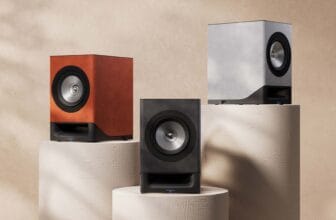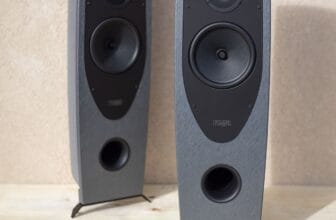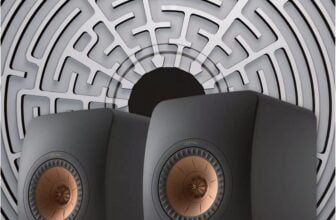ACOUSTIC ENERGY AE320 Review: Go LOW
Acoustic Energy’s new AE32O floorstander digs deep finds Noel Keywood. Read our ACOUSTIC ENERGY AE320 Review.
Acoustic Energy have an audience, a long standing fan base that includes me.Their efforts to combine excitement with fundamental accuracy rightly has followers – and the new AE320 floor stander I’m reviewing here won’t frighten them away, especially at a price of £ (UK).
Tall and slim, theAE320 has been designed, they say, to appeal to overseas buyers demanding more volume to fill big rooms – one reason for multiple drivers. This is a floor stander rated to take 200 Watt amplifiers and, with a high sensitivity of 88dB (loud) from one Watt, it does not need such power in any case. But there you are – a sort-of mission statement. A loudspeaker able to go loud, “suitable for medium to large rooms” they say.Think 15ft long up to 25ft long.
Not blessed with an absence of neighbours, I got up to high volume for short periods only, spending most time at medium to loud.
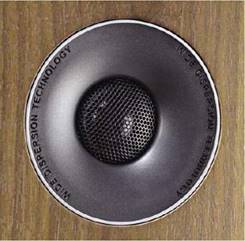
The 28mm aluminium dome tweeter is larger than most (25mm) and is aided by a shallow waveguide to give smooth output up to 20kHz.
For a clean, fast sound the AE320 uses three of the company’s ceramic/aluminium sandwich 130mm (5in) cone drive good dispersion.The bottom two drivers act as extended bass units working up to 250Hz, the next up is a midrange unit that contributes to bass (slow rolloff). It works up to 3kHz before handing over to the large 28mm aluminium dome tweeter that sits in a shallow depression that acts as a waveguide, reaching up to 18kHz.
The midrange unit sits in its own closed chamber, whose walls act to stiffen the cabinet Acoustic Energy point out.The two bass units are loaded by a rear chamber vented by a slot port that our measurements showed gave strong low bass – an important feature within this ‘speaker’s sonic make-up.
The base is weighted by sand in a sealed chamber, making the cabinets heavy at 26kgs; spikes are supplied. Dimensions are Im high, 175mm wide and 320mm deep and mono-wire terminals are fitted, so no bi-wiring. Finishes are Black, White or Walnut real veneer.
SOUND QUALITY
The AE320s were run in, even though they had seen use as early demo samples. Drive amplifier was initially a PrimaLuna EVO 300 Hybrid connected by Chord Company Signature Reference screened cables, but I moved on to our Icon Audio Stereo30 SE that was a better match. Delivering music into the amplifier was our Oppo BDP-205D acting as a CD player, used for its ESS ES9038Pro DAC driven by a linear power supply, giving top sound quality from silver disc.
Hi-res came from a MacBook Pro running Audirvana+ software player to handle PCM and DSD, sending it via USB (DoP) to the Oppo’s USB input.
As an overview, the AE3020s were as clear, projective but naturally balanced and smooth as I had expected, knowing what Acoustic Energy aim for. What took me by surprise – sort- of – was the presence of obvious low bass. I say “sort- of” because measurement had suggested a lively presence from strong port output. But what to expect subjectively? Here goes.
I wasn’t aware that Antonio Forcione’s Tears of Joy (CD), a close-miked acoustic guitar piece, had any low frequency content so was surprised to hear obvious lows coming from this recording, what sounded like a synth backing track adding in sporadic drone; it was low and powerful in my 17ft long room, lifted from the mix to become obvious. There was a reason: my room’s main (length) mode at 33Hz co-incided with this ‘speaker’s port output at 35Hz. For most of the time I heard lively lows as a result, being surprised at just how many tracks had info in this region.There were tracks where the port became overwhelming, notable being Loreena McKennit’s Gates of Istanbul (CD) where sustained deep bass notes were too strong.They would have been less obvious in smaller (14ft) or bigger (>20ft) rooms than mine.This is a room matching issue, raised by a port with strong output where room gain occurs.The simple solution was to put acoustic foam into the ports, just a small amount had a big effect I found. Half an old (wooly) sock would do.

The rear carries a slot port that delivers powerful low bass. Below lie mono-wire terminals and at bottom there’s a cap for the sand chamber that adds weight and stability.
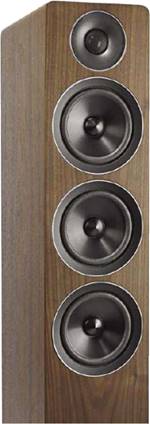
Three 130mm (5in) cone ceramic/aluminium sand wich drive units, topped by an aluminium tweeter, for consistency of material and sound. The two lower units handle bass, the third bass/ midrange.
As delivered the AE320’s port will give strong low bass, making for a powerful sound. These are not bass-light ‘speakers, yet upper bass was quite dry in nature, so think – not a fulsome sound yet with strong deep bass.This would please most listeners I believe. Moving up the audio band, vocals were projected well, without the over-emphasis a raised upper midband can bring, one of those acoustic tricks some designers like to use. Acoustic Energy play it straight here: their cones give a crisp yet even sound that possesses no intrinsic warmth, unlike coated paper or various damped plastics.
Tracks like Alison Goldfrapp’s Let it Take You (CD) with sporadic synth beats highlighted some boxiness in the sound, a slightly boofy quality. But Ms Goldfrapp crooned seductively in the way she does and the AE320s did a great job in making her album Supernature thoroughly enjoyable. Clean and clear, without any sharpness from the tweeter – something I greatly appreciate, something the company consistently achieve.
But I wasn’t quite happy: I felt they were a tad hard compared to what I know of AEs in the past and this prompted me to change over to our Icon Audio singleended valve amplifier that is the epitome of silky smoothness. It worked: the 320s now sounded smooth and easy, even bass receded a little and by just the right amount. Cymbal crashes in Fleetwood Mac’s Dreams (24/96) calmed down and I could more easily play The Eagles Somebody (CD), an edgy, compressed track that is sonically challenging.The ‘speakers are best not partnered with a brighter-balanced transistor amplifier I learnt.Think Naim, Creek, Exposure as a suitable match.
“There was a fine sense of scale here, brass sections rasped out strongly and kettle drum thundered”
The Minnesota Orchestra took on large form playing Korsakov’s Dance of the Tumblers, from The Snow Maiden (24/96). There was a fine sense of scale here, brass sections rasped out strongly and kettle drum thundered in the background, strings were smooth. The speaker’s accurate balance kept all frequencies in order relative to each other, something Classical needs more than Rock.
The Stereo30 SE added in a sense of stage depth to make this and other classical works sumptuous in presentation.
CONCLUSION
The AE320 is a compact floor standing loudspeaker whose deep bass reach gives it a sense of heft others rarely achieve. JBL’s large HDI-3600s managed this but at twice the price, illustrating the value of what is on offer here.The snappy character of the ceramic/aluminium drivers needs sympathetic amp matching, a softer milieu being best in my view, but perhaps this is a matter of taste. At the price I’d rate the AE320s as a great package, one well worth hearing.
MEASURED PERFORMANCE
Frequency response of the AE320 stretches from a low 30Hz up to 20kHz our third-octave analysis of pink noise shows. Other measurements made clear the forward response rolls down slowly and smoothly below 200Hz to -2dB at 100Hz and -6dB at 55Hz, a characteristic suitable for near wall use.
The port has very strong output at 35Hz, providing strong subsonics, especially with Rock where lows in the 30Hz region exist – not uncommon with synthesisers. So dry controlled bass, but with a big low-end kick.
There’s no plateau treble lift for artificial enhancement, the tweeter working smoothly to 18kHz except for a small peak at 10kHz.
The drive unit immediately below the tweeter covers the midrange and some bass, whilst the two lower units identically cover all lows up to 250Hz, acting in effect as wide range bass units. They are loaded by a slot port at rear. It’s resonant, making the ‘speaker a reactive load, rather than resistive. It gives less damped, livelier bass.
Overall impedance was high at 8.4 Ohms making the ‘speaker a light load in terms of current draw, and this can be seen in the impedance trace as height above the x-axis. All the same, voltage sensitivity was good, 88dB being delivered from one nominal Watt (2.8V) of input. That’s loud, making amplifiers down to 40 Watts sufficient for very high volume.
The AE320 follows Acoustic Energy’s design approach of producing a fast yet accurate sound. With fine results all round the AE320 will perform well in use, with powerful subsonics.
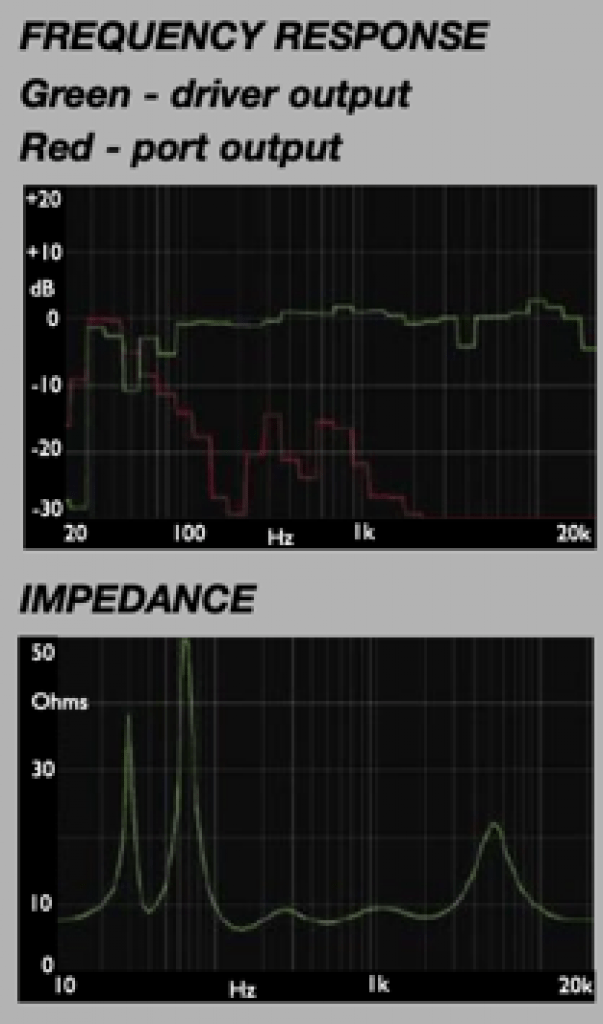
OUTSTANDING – amongst the best.
VALUE – keenly priced.
Acoustic Energy
www.acousticenergy.co.uk



